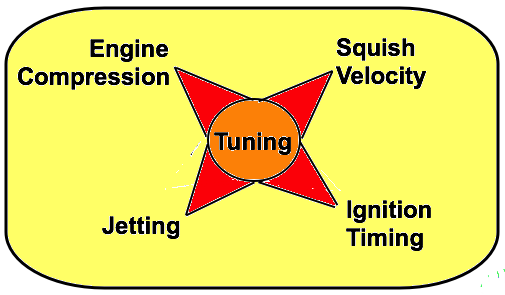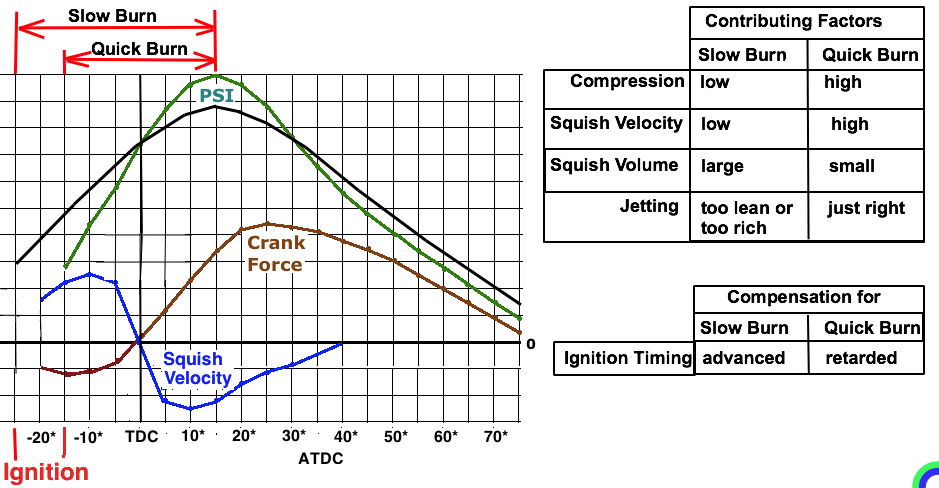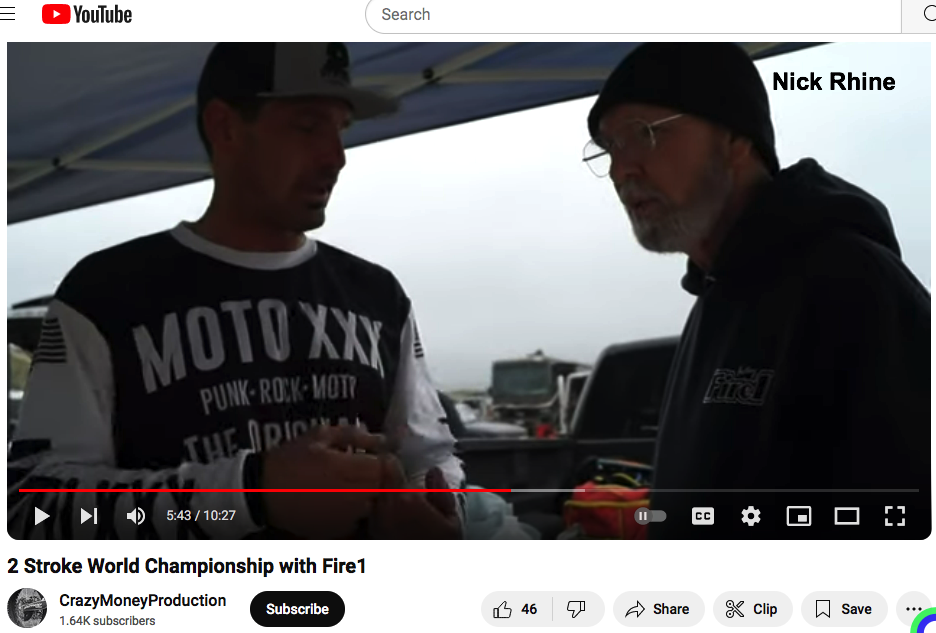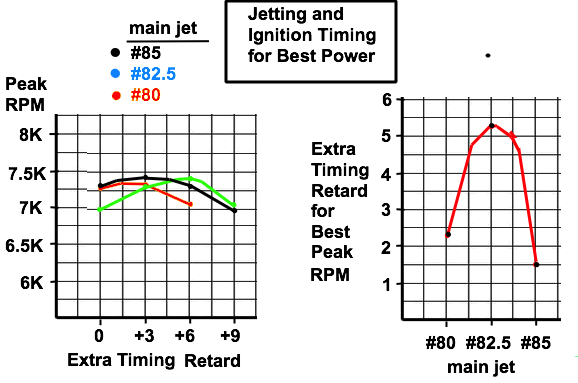| the Best No-Cost Method Here's the 4 factors involved in tuning:  They all influence the combustion burn time. Generally speaking you want a faster burn for a race bike than for a street or trail bike. Once everything is set for the best burn time for the engine then you need to find the ignition timing setting that matches that. The right timing will be what gives you the best power. Look at the drawing below. The ideal peak combustion pressure for all engines is between 10 and 15 degrees after TDC. So the ignition timing needs to work with the other "burn time factors" to acheive the best peak pressure between 10 and 15 degrees.  Tuning Sequence So here's the sequence for tuning: "Good Enough" for non racers is just testing with an average riding situation and finding the main jet that gives the best acceleration. Hopefully the mid range jetting is correct already. The best method for racers wanting every little advantage is : 1. Choose the squish velocity and volume according to max RPM and compression by using software that is designed to calculate both of those and give you suggestions to get closer to the ideal. My squish calculator is the only one I know of that does that, and it's only $15. 2. Choose the main jet by trying different ones while testing for best acceleration or best top speed / RPM if the engine is small. The testing situation should represent the average of what you ride. For example, if you're racing the hilly Glen Helen motocross track then you'll need to test acceleration up a medium sloped hill. That's what Nick Rhine did to tune his winning bike for the 2019 Two Stroke World Championship race at Glen Helen. His bike won that year, and two other consecutive years.  3. Then retard the timing by 3 degrees and retest the 3 main jets. Then advance the timing from the beginning setting by 3 degrees and retest the 3 main jets. 4. Out of those 9 setups keep the main jet and timing that gives the best acceleration and the most retarded timing. For my 48cc the #85 with #1 timing and the #82.5 with #2 timing gave equal best results. #2 timing was 3 degrees more retarded than the #1 timing so the #82.5 jet was the most ideal for riding the flat streets of this city. But I could choose the #85 setup for best reliability with the engine running a little cooler. These graphs are the result of my testing:  5. Lastly you need to make sure you are using good oil. That is because tuning an engine for highest power usually also means a higher engine temperature, although maybe not a whole lot more. But I believe tuning should include making sure the engine will last, and so that's why I'm including this section about engine oil. You should choose an oil which A) doesn't have a lot of viscosity modifiers to artificially make it look good on its specs page while inside your engine it's limiting lubricity, B) is not an FD rated oil if you are racing because those oils have anti-smoke additive that limits lubricity, C) doesn't have more than 20% group 1 mineral oil which is the worst oil which instantly evaporates off hot engine parts and is the worst at leaving black deposits. These oils have 20% or over group 1 oil: Yamalube 2R : 67% group 2, 29% group 1 PJ1 Goldfire Pro Racing : over 35% group 2, under 30% group 1 Amsoil Interceptor : ~22% unspecified synthetic, 10% group 2 oil, 20% group 1 oil AMSoil Dominator : 32% synthetic oil, 45% group 1 oil Putoline MX5 + MX9 : synthetic oil, 25-50% group 1 oil Castrol Power1 Racing 2T (TTS) : ?% synthetic oil, 35% group 1 oil Lucas High Performance Semi-Synthetic 2-Cycle Oil : synthetic oil, 20% group 1 oil Bel-Ray SL-2 : 30-40% Polybutene (viscosity modifier), 20-40% goup 2, 30-40% group 1 oil Castrol Go! 2T : 70% group 2, 20% group 1 Motorex Power Synt 2T : synthetic oil, 25-50% group 1 oil Motorex Cross Power 2T : Synthetic oil, 10-30% Group 1 oil Repsol Moto Off Road 2T : Synthetic oil, under 25% group 1 oil Schaeffer 9000 2-Cycle Oil : 35-50% group 2 oils, 20-35% group 1 oil Red Line AllSport : ~20% synthetic oil, under 45% group 1 oil Red Line Two Stroke Racing Oil : 30% synthetic oil, under 50% group 1 oil Matching Engine Oil to Type CDI CDI's that retard the timing during a high load situation such as going uphill give the best power from using a fast burn oil. And non-adjusting CDI's give the best high load power with a slow burn engine oil. Click here to read more. Matching Engine Oil To Engine Heat My final advice on engine oil selection is to match the oils heat resistance to the heat of the engine, which we generally know by knowing the heat range NGK # the engine uses. Synthetic and castor oil have the highest heat resistance (which is why they produce more spooge). Next is group 2 mineral oil, and then group 1. High NGK #'s are for the highest heat engines. A mid heat engine uses a #8 spark plug. So look on my engine oils page to see what is in each engine oil. This breakdown comes from their own safety data sheets where every oil other than synthetic oils are listed there for each product. So up to a #7 engine can use a product with both group 1 and group 2 oils although I'd stay at a low % of the group 1. A #8 engine can use an engine oil made of just group 2 mineral oil such as Amalie SynPlus, or any good semi-synthetic oil. A #9 engine can use a good semi-synthetic oil with little to no group 1 oil in it. The best is Kawasaki Two Stroke Racing Oil because it has no group 1 in it. A #10 engine should use an engine oil with less than 10% mineral oil in it such as Castor 927 or Motul 800. Is this the best method of tuning for all 2 strokes? I believe it is. Whether the engine is a high RPM racer or a mid RPM trail bike, the best tuning will give the best power for that engine. A low RPM trail bike will have a lower exhaust port and so a longer burn is needed for that desired grunty power. But the engine will tell you what tuning it wants. It's "talk" is its response to the different settings. A positive response is higher engine power. If my testing show two main jets to give the same power then which one should I use? That depends on the slope of the ground you tested on and the average of what you ride. If ythe average of what you ride is more (ie: a higher load) than what you tested on then use the bigger jet. Otherwise use the smaller jet. What about mid throttle jetting? Before testing for the main jet you should test mid throttle which depends on needle taper angle, needle height, and needle to needle jet clearance. The right tune for a racer causes the exhaust note to sound a tiny bit sputtery which is slightly rich so that cracking the throttle open gives instant acceleration. For trail and street riding the mid throttle should be leaner which allows you to cruise mid throttle without any symptoms of being too rich. Once you get mid throttle right then do this testing for the main jet. What if the best ignition timing for top RPM power isn't the best for mid range? Then you need to select timing (via position of stator coil plate) for something between those two extremes. Street and trail bikes often have an ignition curve of the CDI that doesn't retard the timing enough at high RPM which causes this little problem. Here's my video on this subject: Click here |